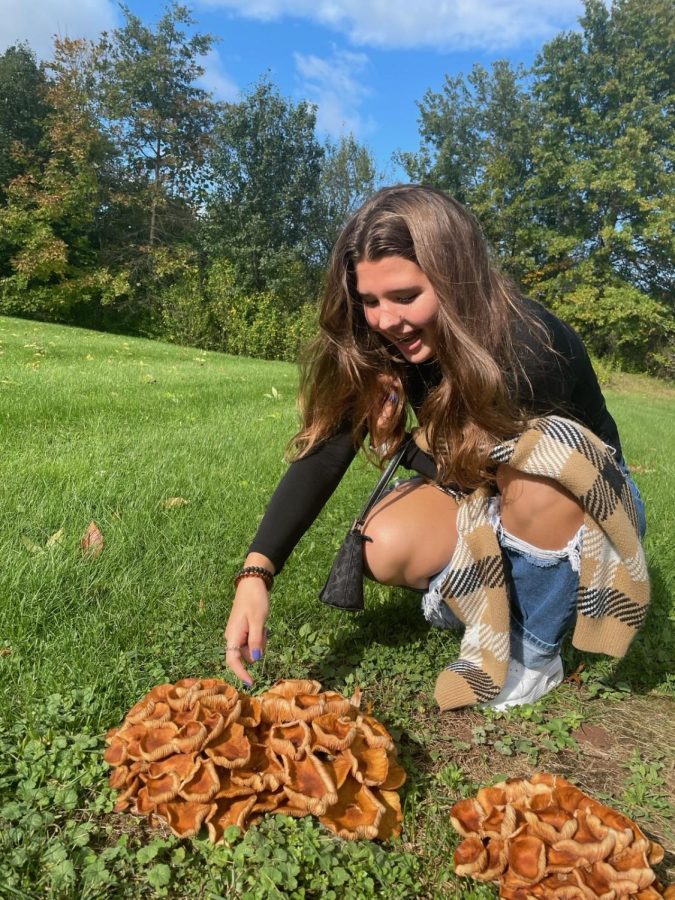Fungi provide mass, underappreciated assistance to ecosystems
To allow entire ecosystems to thrive, fungi support all organisms in a variety of ways. Though fungi can be considered the backbone of the earth’s ecosystems, they are often underappreciated.
Pumpkin patch…Investigating the fungal bloom on the ground, junior Lily Hasset finds a pumpkin mushroom. Mushrooms can be found anywhere nutrients is available.
By linking other organisms together and breaking them down after death, fungi hold an important presence in both the natural world and many aspects of human life.
Although they can often be hard to find, different types of fungi make up a crucial part of many ecosystems.
According to science teacher Kimberly Wilson, many environments could not function without the assistance of fungi.
“There’s such a hidden world of mushrooms, and the whole earth could not function without that hidden world,” Wilson said.
Wilson said that although this “hidden world” is important, it is often under-recognized because it is invisible to most people.
“It’s underground, and it’s hard to study because it’s underground. We don’t see it, so for a lot of people that doesn’t exist.”
Fungal diplomat Loni Jean Ronnebaum said that the field of mycology still has a lot to explore.
“The fungal kingdom is undervalued, understudied and so much is still left to be discovered,” Ronnebaum said.
Fungal diplomat Justin Tulloss is excited about the vastness of the field.
“Though the amount left to learn about fungi is daunting, it’s more of an exciting whirlwind of activity and discovery than it is an overwhelming experience,” Tulloss said.
According to Wilson, mushrooms and other types of fungi are responsible for cultivating healthy soil and breaking down organisms so their nutrients can be reused.
Wilson said that these fungi are also “vital” to the growth of plants and trees.
“They’ve done studies that show when you take a plant out of its native environment, and you put it into a different environment, and it doesn’t have the same fungi, it won’t thrive as well,” Wilson said. “That’s why native plants do so well; it’s because they’re in a community with other mushrooms.”
Wilson said that mycelium, the sprawling underground fungal networks, grow in a similar way to the neural networks in brains.
“People have been studying it to think about big communication systems,” Wilson said, “and people who produce artificial intelligence look at mycelial networks and try to make something that’s similar to a mycelial network.”
Science teacher Ian Burley said that when people think of fungi, they usually think of fruiting bodies such as mushrooms instead of the “vast network” that sprawls underground.
According to Burley, this network of fungi is used by the ecosystem to allow different organisms to interact with each other,
“It communicates with other organisms by providing them nutrients,” Burley said.
According to Ronnebaum, this network is also sometimes called “the Wood Wide Web.”
Environmental enthusiast Jess Byerley has an interest in mushrooms because of her foraging hobby.
“Our world is practically run by a crazy microenvironment underneath the ground because of mushrooms,” Byerley said.
Burley believes that mushrooms are interesting “because of their toxicity.”
According to Burley, “anything with toxins is valuable in the field of medicine.”
According to Tulloss, this is because of how closely mushrooms are related to humans.
“Since we are so closely related to mushrooms, they have to fight off many of the same diseases that we do,” Tulloss said. “So they make compounds to protect themselves, and we can benefit by consuming those compounds.”
Wilson agrees that fungi play an important role in the medical field. “We don’t have to go and make medicines. We just find these fungi that are producing them already and test them,” Wilson said.







